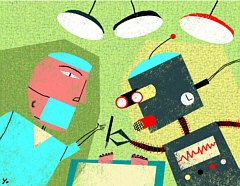
|
|
APRIL 2000 CONTENTS
|
|
PIONEERS GUEST BOOK
|
| Robots in the operating room? Such devices may well hold the key to more accurate, less invasive surgery. |
|
Opening illustration by James Yang |
Pioneers of Promise
· · · · · · · · · · · ·
"Assisting Me Today
in Surgery..."
By Joanne Cavanaugh Simpson

In the new century, a surgeon's best assistant may be a robot. In a joint research effort encompassing several Hopkins departments, faculty members are heading up a national effort to bring computer imaging and robotics to the operating theater and other medical arenas.
Already at Hopkins, surgeons are using a robotic device in kidney surgery. Comprised of a camera attached to a robotic arm, the device allows doctors accurately to insert needles in the kidney to help dissolve kidney stones.
Such devices could become commonplace, assisting surgeons in challenging procedures where hand tremors and exploratory surgery would prove dangerous--including retinal microsurgery (being developed at Hopkins), tissue removal from the spine or brain, or, potentially, the exact placement of needles in tumors for chemotherapy or gene therapy.
"These procedures would be less invasive and more accurate," says Russell H. Taylor, computer scientist, robotics expert, and director of Hopkins's Engineering Research Center in Computer-Integrated Surgical Systems and Technology.
The National Science Foundation two years ago awarded a $12.9 million grant to fund the Hopkins-led research center, the nation's first. Partners include the Massachusetts Institute of Technology and Carnegie Mellon University. At Hopkins, researchers and physicians from Urology, Radiology, Ophthalmology, Surgery, Orthopedics, Neurosurgery, Comparative Medicine, and other departments are participating.
"The goal is to bring together scientists, engineers, computer scientists, and physicians to form teams [that will lead] research and applied programs," says center deputy director James H. Anderson, a professor of radiology at Johns Hopkins School of Medicine.
Another primary mission: To develop standard image-guided technology that would, for example, allow surgeons to create 3-D computerized medical images of a patient, using MRIs and other techniques. Doctors could then draw up highly precise preoperative surgical blueprints.
Taylor believes such changes in the way medicine is practiced could be as momentous as the automation revolution was to the 20th century. These advancements, he says, "will enable the development of new kinds of therapies and improve the way current therapies are done."
RETURN TO APRIL 2000 TABLE OF CONTENTS.